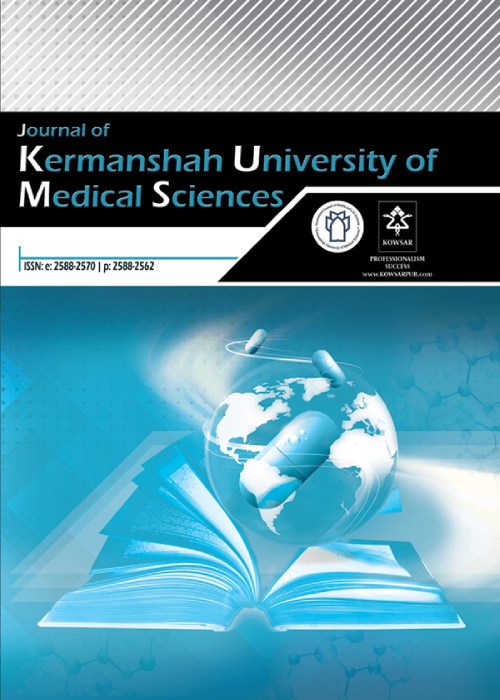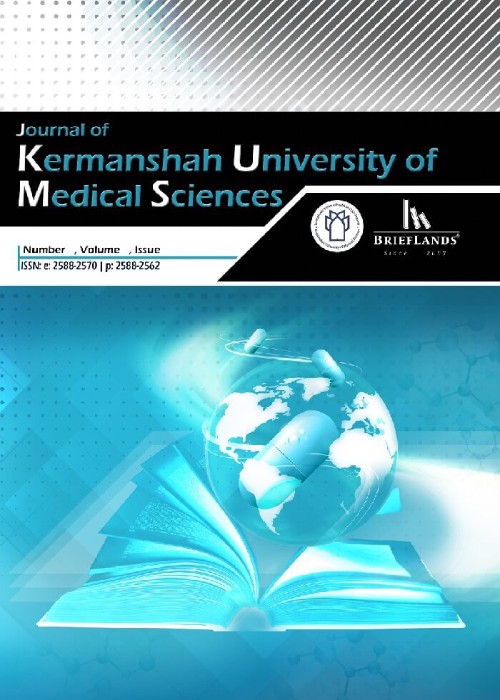فهرست مطالب

Journal of Kermanshah University of Medical Sciences
Volume:27 Issue: 1, Mar 2023
- تاریخ انتشار: 1401/12/01
- تعداد عناوین: 8
-
-
Page 2Background
Herpes simplex viruses have been implicated as a cause of cardiovascular disease (CVD) due to their widespread distribution and ability to infect human vascular endothelial cells.
ObjectivesThe present study aimed to evaluate the link between Herpes simplex infections and cardiovascular disease.
MethodsThis case-control study involved 236 patients aged 35 - 65, 118 with known cardiovascular disease and 118 controls. Patients’ cardiovascular disease evaluation was based on data from questionnaires, a specialist’s physical examinations, and paraclinical tests. Herpes simplex viruses (HSV)-antibodies (IgM, IgG) were determined using ELISA in serum samples, and the biochemical blood indicators were analyzed to examine their relationship to the level of HSV antibodies. All the data were analyzed using SPSS software version 20.
ResultsIgM antibodies against herpes simplex were negative among all 236 patients. The positivity rate of IgG antibodies against herpes simplex was 58.8 and 51.2% in the case and control groups, respectively with no significant difference (P = 0.253). Patients with cardiovascular disease had a 0.587-fold higher positive rate of IgG antibodies than patients in the control group (odds ratio (OR) = 0.587). The mean age of patients with positive IgG antibodies was significantly lower than patients with negative IgG antibodies (P = 0.012). IgG positivity among men and women (P = 0.670) and different job statuses (P = 0.866) were not significantly different.
ConclusionsThe positivity rate of IgG antibodies against herpes simplex was not significantly different among the study groups. Although patients with positive IgG antibodies’ mean age was lower than those with negative IgG antibodies, the gender and job status were not different.
Keywords: Herpes Simplex, Cardiovascular Disease, IgG Antibodies -
Page 3Background
The incidence of stomach cancer in Iran, especially in the western and northwestern regions, has increased in recent years.
ObjectivesThis study aimed to report the identified factors related to stomach cancer in Hamadan province.
MethodsIn this retrospective descriptive study, the data were collected by a researcher-made checklist. The 1: 2 matched controls were considered for each patient. Controls were age (± 5 years) and sex-matched. The control group was selected from a hospital sample with and without a family history of cancer. The data analysis was analyzed using a conditional logistic regression model under Stata software.
ResultsA total of 100 patients (male n = 77 and female n = 23) with gastric cancer (cases) were studied. The results showed that many variables such as smoking (P < 0.05), blood type (P < 0.05), job (P < 0.05), red meat (P < 0.05), pickle (P < 0.05), hot food (P < 0.05), salt (P < 0.05), alcohol (P < 0.05), and black tea (P < 0.05) were risk factors and variables such as education (P < 0.05), vegetables (P < 0.05), fruit (P < 0.05), fish (P < 0.05), physical activity (P < 0.05), broccoli (P < 0.05), and garlic (P < 0.05) were the preventive factors for gastric cancer. There was no difference between the investigated factors of controls with a family history of cancer and those without one.
ConclusionsHealth and treatment organizations and health policymakers are expected to reduce the incidence of stomach cancer by raising awareness and promoting proper diet by reporting the preventive and risk factors.
Keywords: Gastric Cancer, Stomach Cancer, Risk Factor, Family History, Nutrition Status -
Page 4Introduction
The study aimed to discuss the diagnosis and treatment of a six years old boy with severe pre-eruptive caries with preservation of pulp vitality after surgical exposure in the permanent mandibular molar. Pre-eruptive intra coronal caries are often an accidental lesion as a radiolucent finding in the coronal dentin of a tooth which did not erupted into the oral space (1). However, treatment modality is still not reported systematically (2).
Case PresentationThe preventive approach effectively preserved the tooth vitality with no symptoms, while normal root development is processing during follow-up sessions.
ConclusionsAccurate radiographic examination in visit and follow up sessions is fundamental for proper detection and intervention in pre-eruptive caries lesions.
Keywords: Apexogenesis, Occult Caries, Permanent Tooth, Pre-eruptive Caries -
Antibiotic Resistance Profile Among Stenotrophomonas Maltophilia Clinical and Environmental IsolatesPage 5Objectives
This study was conducted to compare the resistance profile of Stenotrophomonas Maltophilia isolates -collected from clinical and environmental sources in a hospital- for different antibiotics to clarify their clonal relatedness.
MethodsIn this study, a total of 22 S. maltophilia isolates collected from 400 different clinical and environmental samples from Imam Reza Hospital were subjected to the analysis. Antibiotic susceptibility testing for each isolate was carried out by the disc diffusion method and according to the CLSI guidelines.
ResultsAmong22 S. maltophilia isolates, ten isolates were obtained from clinical specimens, and 12 were obtained from the environment. The isolates showed the lowest and highest antibiotic resistance to chloramphenicol and trimethoprim-sulfamethoxazole (18.2%) and meropenem (100%), respectively, and resistance to the other antibiotics were as follows: Chloramphenicol 18.2%, trimethoprim-sulfamethoxazole 18.2%, gentamicin 22.7%, tobramycin 50.0%, aztreonam 63.6%, amikacin 63.6, ceftriaxone 68.2%, and ceftazidime 68.2%. The antibiotic profile of S. maltophilia strains differed from tobramycin, aztreonam, amikacin, ceftriaxone, trimethoprim-sulfamethoxazole, ceftazidime, chloramphenicol, and gentamicin between clinical and environmental samples.
ConclusionsBased on the high antibiotic resistance of S.maltophilia isolates and various responses to the selected antibiotic, chloramphenicol is the best therapeutic option, with 81.8% susceptibility. The early diagnosis and determination of antibiotic resistance patterns have the utmost importance.
Keywords: Stenotrophomonas Maltophilia, Antibioticresistance, Environmental Source, Hospital Infection -
Page 6
The Cushing syndrome typically presents with abdominal obesity, wide purple striae, glucose intolerance, hypertension, easy bruising, and muscle weakness, a rare disorder interfering with ovulation, making the combination of Cushing syndrome and pregnancy less common. Nevertheless, Cushing syndrome has been reported in pregnancy. Here we report another case of pregnancy with Cushing syndrome, which presents merely with obesity, hypertension, and glucose intolerance, using a literature review at the end.
Keywords: Pregnancy, Cushing, Hypertension, Glucose Intolerance -
Page 7Background
Cardiac troponins T and I as markers of specific myocardial injury have been associated with acute ischemic stroke. Several mechanisms have been proposed as the possible cause of myocardial damage in stroke patients. The level of troponin and its association with electrocardiogram has not been studied yet among Kurdish population.
ObjectivesThe present study evaluated troponin’s level and compliance with electrocardiogram findings among Kurdish patients with acute ischemic stroke.
MethodsPositive troponin was investigated among all acute ischemic stroke patients who were admitted to Imam Reza Hospital in Kermanshah from 21 March 2018 to 20 March 2019. Comprehensive electrocardiography examinations were performed and interpreted by a cardiologist and a neurologist. The presence of Q wave, T wave inversion, and ST-segment elevation or depression as evidence of coexisting cardiac ischemia were compared between patients with positive and a randomly selected group of patients with negative troponin.
ResultsA total of 13.2% of participants (n = 21) had atrial fibrillation (AF). One patient with positive troponin and 13.4% (n = 20) of patients with negative troponin had AF in their ECGs (P = 0.67). The frequency of other disorders, including T wave inversion, left branch bundle block, ST-segment elevation, and the presence of pathological Q wave, was 6.3% (n = 10), 5.7% (n = 9), 5% (n = 8), and 5% (n = 5), respectively. The results showed no significant relationship between positive (increase) or negative troponin with electrocardiogram abnormalities (P > 0.05).
ConclusionsSince routine ECGs are obtained from all acute stroke patients, routine troponin measurementsmaynot be necessary for all patients and can be limited to those with electrocardiographic abnormalities.
Keywords: Troponin, Electrocardiography, Ischemic Stroke, Arrhythmia, Cardiac Inflammatory Markers -
Page 8Background
Heart disease is the mostcommoncause of mortality worldwide, and heart surgery frequently occurs. The results are strongly dependent on lifestyle modification and especially sports exercises.
ObjectivesIn this study, aimed to compare the effect of eight weeks of aerobic and combined training on systolic cardiac function in heart failure patients after coronary artery bypass surgery.
MethodsIn this randomized clinical trial, 30 cardiac patients under CABG surgery at Kermanshah Heart Center were randomly divided into three groups, control, combined, and aerobic training. The protocols of the combined group included two movements of the upper limbs (pectoralis major and deltoid muscles) and two movements of the lower limbs (quadriceps and hamstring muscles) by three sets/10Rep and aerobic group with 60 - 85-minute exercises at 70 - 85% peak HR in three sessions per week for eight weeks. The collected data were analyzed using the SPSS software version 22, One-wayANOVA,andTukey tests; P< 0.05wasconsidered significant.
ResultsAfter eight weeks, Systolic heart function wasn’t increased in the control group (P > 0.05) but was raised in the aerobic and combined training groups (P = 0.0001). There was no significant difference between in two intervention groups (P > 0.05).
ConclusionsAerobic and combined exercises positively affect systolic cardiac function after coronary artery bypass surgery. Therefore, doing both exercises in these patients is recommended.
Keywords: Aerobic Exercise, Resistance Training, Heart Failure, Systolic Cardiac Function


